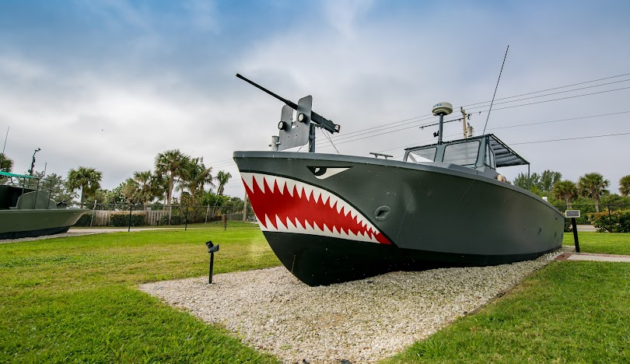By Carmen McGarry | Contributing Columnist
Located on North Hutchinson Island in Fort Pierce, the National Navy UDT-SEAL Museum houses exhibits of the Navy Underwater Demolition Teams (UDT) and the Sea, Air, Land (SEAL) teams, histories that include the original Navy frogmen who trained there.
A former UDT frogman, Albert Stankie served in World War II and worked to acquire the museum and site at 3300 N. Hwy. A1A. It opened in 1985 and is on land owned by the state. The forerunners of the SEALS, the Naval Combat Demolition Units (NCDU) and Underwater Demolition Teams (UDT), began training in Fort Pierce in 1943 in anticipation of the Normandy invasion.
Thanks to rescues, movies, the killing of Osama bin Laden and other events, one of the most secretive military groups in America has become very high profile. Since 1945, over 48,000 men have applied to become SEALs but only 8,000 have completed this most rigorous training.
After World War II, they saw service in the Korean War with raids on railroads, bridges and tunnels. During the Vietnam War, they became the greatest commandos with their guerrilla warfare. In 1946, the Navy moved operations to Virginia and then to California.
In 1962, the SEALs received their current designation. President Kennedy recognized their value and commissioned them as Sea Land Air Teams. In the 1980s a group began collecting artifacts and by November 1985 they had opened the 3,500 square-foot museum in Fort Pierce.
The museum includes artifacts dating from the days of Scouts and Raiders, the Navy’s first special warfare commandos, to modern day SEAL activities. Included are artifacts used for the Normandy landings, the Shark Tooth boat used in World War II and Korea, training devices used by the UDT frogmen teams during the Apollo, Gemini and Mercury space missions, vehicles used to enter enemy harbors clandestinely and operations in Kuwait, Afghanistan, and Iraq. Also on exhibit is the lifeboat aboard which Somali pirates held Captain Richard Phillips hostage during the hijacking of the container ship Maersk Alabama in 2009.
Also housed in the museum are patrol boats, submarines, beach barriers and exhibits showing SEAL canine units; video, weapons and documents with information from its beginning to the present day.
Considered the museum’s focal point is the UDT-SEAL Memorial bearing the names of hundreds of SEALs and those who came before them, etched in black granite, who died serving their country. Added recently are the 17 names of those who died when a Chinook helicopter transport was shot down by the Taliban in 2011. The centerpiece of the memorial is the 500 pound, 9-foot tall bronze sculpture of a modern SEAL.
A souvenir shop with SEAL memorabilia is a great attraction for visitors. Special events are held several times a year. The Navy SEAL Museum was recognized as a National Museum by an act of Congress signed into law on Feb. 7, 2008.
Visit navysealmuseum.org for more information.


Leave a Reply
You must be logged in to post a comment.